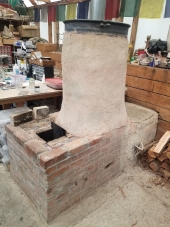Thank you Jeff, Peter & R Scott. I take all of your thoughts to heart and appreciate your thoughts on this.
I built glass furnaces, as well as taught furnace building here in Ireland for about 6 yrs, so I do come with some "unlearning" to do, no doubt, but also some knowledge of "playing with fire". I went through a series of designs, the best of which came at the end of that tenure for me. I gave it up as it was so expensive and in my eyes impractical for our environment. This is the first time I am considering melting glass again, using one of these cool stoves.
That aside:
Since all these posts, and after "Big Al's" I persisted and got her burning fairly well. Kept it burning, but had backdraft that kept putting it out. After blowing on it, it started up again... lots of hot coals though. Partially I found placement of my sticks was helpful and towards the end of my testing when the coals were building up, covering the hole with a bit of brick increased the flow so it burned well, and resisted the backdraft. I had to leave before it completed, so I don't know yet how much burned up, or if there is a good deal of ash or charcoal left from the burn.
Thoughts on comments:
rough lines improved burn in a glass furnace, but I can see now how it can really mess up my system.
testing minus the barrel, then minus the flu is a great suggestion
Peter; there is insulation around the flu out of the burn chamber, where else would I need any? I don't see any description or sketches showing other insulated spaces-or did I totally miss something?
Can you clarify why you feel changing the brick thickness would matter Peter? my understanding is that we are dealing with internal spaces, not external?
I guess, Peter, you are suggesting a larger riser from the burn tube, so that the transition from square to round is better? I tend to think is flows well enough there, that that might be minor in consideration of other issues, or am I wrong about that? Seems the test with just that riser will help a lot to see how it does.
length of system, Peter: the guide says 30' for 8", 20-25' for 5", I went for about 15-20 for 4". But will test it with 10-12', as the last 8' is not built yet, just attached on for testing.
vertical chimney was very short initially, and had problems. I increased it with that last test burn and that made a big difference. I'll work on getting that properly setup.
barrel size: should I shorten it? Or is it too big around all together? Is it a problem with too much space between insulated riser and the OD of the barrel?
I went with 4" as that is what I had, as I said, but also, I want a smaller system. I have a very well insulated 23' yurt this is in, I'd like it to be warm but not overly hot. Thus a smaller system (in my practical mind) makes some sense. I know from furnace building and the origins of rocket stoves, small is very possible... so why can't we size down the mass heater? I am hard pressed to see argument saying it can't happen, but do agree R Scott that it is likely on the small side of draw, especially if I am too long. Filling with ash and reducing it hadn't come to mind (another important point I overlooked on some level). So, I need to introduce another access hole for sure at my 180 degree bend to deal with that I think.
I am feeling that I will need to pull the rough flu... sadly. Thought that was so perfect! It's used as replacement chimney liner all over this part of the world, and jus't didn't occur to me, even though the mention of a clean straight pipe in the guide is there.
Lastly, R Scott, I don't think, reading now, that "Big Al" was being cruel... but as a first response it was not a good one. I taught furnace building for years... I'd certainly congratulate efforts before pointing out problems...
![]()
where ingenuity is in place. Mistakes are the pillar...
Thank you all hugely for your input. I've been pushed by Al to prove him wrong (not a bad thing! we can all learn, eh?) and now have a lot to consider going forward and best of all, R Scott, practical testes to perform at this point.













 2
2








































